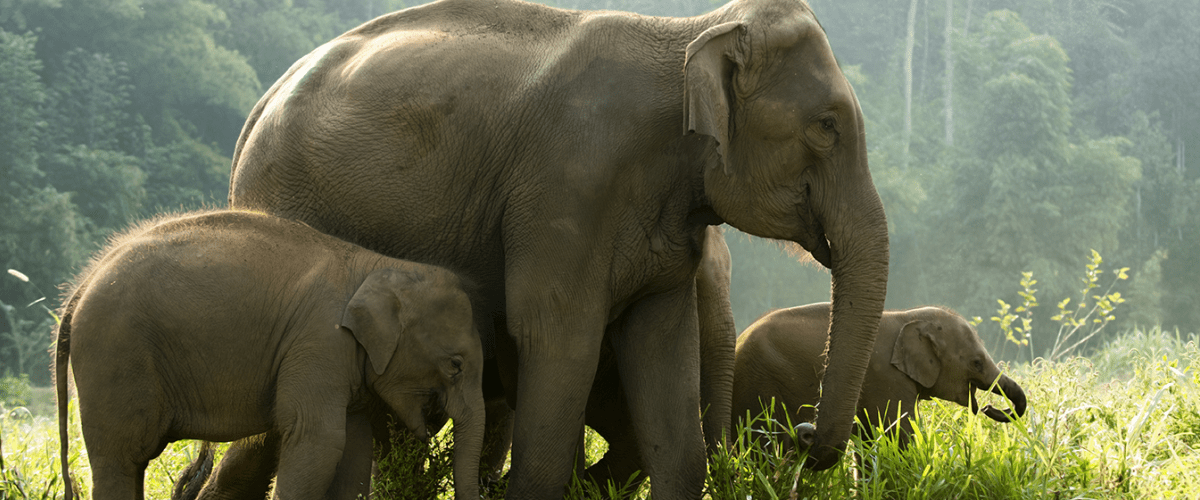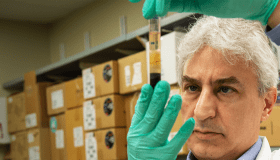
September 7, 2023 — What happens when a gorilla starts to sneeze and cough? Who ensures an injured hawk receives its pain medication? Which medication do you give a sea turtle suffering from red tide? When the health of our wild animals falters, it's the Foundation that our devoted caretakers, diligent managers, and skilled veterinary team turn to for aid.
Morris Animal Foundation stands apart from many animal health organizations. This is due to our commitment to funding research for all diseases and health challenges across all species. In the 1950s and early 1960s, our reputation for supporting vital research in dog and cat health began to flourish. Consequently, it was only a matter of time before experts in wild animal health approached our organization, inquiring whether we would extend our funding efforts. In 1967, we funded our first wildlife health project, and we haven’t looked back!
When the legendary Betty White first partnered with the Foundation, her passion extended beyond the realm of dog and cat health, encompassing the vital arena of wildlife as well. Her involvement significantly elevated our profile and amplified our mission to enhance wildlife health. The Betty White Wildlife Fund was established in 2010 by the cherished actress and dedicated animal advocate. Betty’s generous contribution was directed towards funding research projects aimed at addressing the profound and adverse impacts on marine life resulting from the Deepwater Horizon oil disaster in the Gulf of Mexico. This fund persists in offering crucial financial backing to safeguard the well-being of animals across the globe.
It’s been an ambitious undertaking to address the health needs of wild animals but for us and for many of our donors it’s a labor of love. Our funding initiatives are instrumental in bridging critical gaps in health knowledge, encompassing not only the charismatic megafauna of the world, such as koalas, elephants, rhinos and dolphins but also the often-overlooked, smaller denizens of the wild. These lesser-visible species, like freshwater mussels, crickets, salamanders, and many others, play indispensable roles in the planet's ecosystems.
Our work encompasses a crucial yet neglected aspect of the wildlife conservation: wildlife health care and management. The new information generated through our funded studies supports the development of new and improved diagnostics, treatments and preventive strategies. It helps both free-ranging and managed conservation animals, and even rescued wildlife. Thus far, our impact has reached more than 25,000 species globally.
Here’s a snapshot of how our funded studies have helped wildlife across the globe:
- Our funding helps researchers respond to disease outbreaks – from identifying the cause of the outbreak to finding solutions to mitigate future outbreaks. This work includes saving endangered animals like Asia’s saiga antelope and the African wild dog.
- Investing in reproductive health and assisted reproductive technologies helps build genetic zoos to hedge the extinction of threatened and endangered wildlife from frogs to pandas.
- Our funding supports rehabilitative care to improve diagnostics and treatments, giving thousands of animals every year a second chance to live longer and healthier lives in the wild.
- Cancer affects wildlife too, and our Foundation has a long history of supporting animal cancer research.
- Long-term concentrated funding often is needed to help species teetering on the brink of extinction. One of our best-known, historic funding efforts is the Mountain Gorilla Project.
Disease Outbreaks
Wildlife disease outbreaks are alarming and can result in the deaths of countless animals. Over the years, the Foundation has supported wildlife health studies addressing existing and emerging disease outbreaks caused by viruses, fungi and parasites.
One recent outbreak caused several mass die-offs of endangered saiga antelope, a species of rare antelope native to central Asia. The deaths were caused by a disease commonly found in goats and sheep. The Foundation responded promptly, helping researchers confirm the causative agent that, before this mass-die off incident in Saiga, had never been recorded in any antelope species in the world.
Our funding also helped provide important, boots-on-the-ground training for wildlife managers, teaching them how to document and analyze results in deceased saiga antelope and how to monitor and survey other potentially-impacted wild animal species. This new information helped inform policies on how to control and mitigate the spread of this disease into wildlife globally, leading to earlier diagnostics, better disease surveillance and preventive strategies.
Other top disease outbreaks we have helped address that led to life-saving research for threatened and endangered wildlife include:
- Rabies in endangered African wild dogs and bats
- Respiratory disease in great apes and penguins
- Canine distemper in tigers and African wild dogs
- Morbillivirus (similar to distemper) in marine mammals
- Avian cholera in wetland birds
- Plague in prairie dogs and ferrets
- Encephalomyocarditis virus that causes fatal heart infections in elephants
- White-nose syndrome, a fungal disease in bats
- Tuberculosis in multiple species
- Tick diseases in moose
In recent years, thanks to big data, researchers are turning their attention to developing disease models that can help forecast potential disease outbreaks. Researchers hope that by knowing triggering risk factors for certain diseases, including environmental factors and key animal hosts of the disease, disease modeling using big data will help them respond to situations before high mortality events occur.
Reproductive Health
Addressing dwindling populations poses a significant conservation challenge. A key concern is how to bolster the birthing success of at-risk species to mitigate the threat of extinction. Over the years, Foundation funding has been instrumental in supporting studies on reproductive health. This has involved the development of assisted reproductive technologies, gaining insights into reproductive diseases, and exploring factors like stress and noise that impact reproductive success.
We’ve helped a diverse group of species – from lemurs to rhinos, frogs to giant pandas and songbirds to cheetahs. Some recent studies are helping solve reproductive challenges in polar bears, coastal wetland birds and African forest elephants. And thanks to our funding, new information and techniques continue to improve breeding programs and help maintain genetic diversity of threatened and endangered animals around the world.
Rehabilitative Care
Every year, rehabilitation facilities give thousands of injured or sick wild animals a second chance of living their lives in the wild. However, different species often require different specialized care. To fill this wildlife health need, Morris Animal Foundation funds studies to improve anesthesia, pain management, treatments and health monitoring tools so veterinary professionals at wildlife rehabilitation facilities can provide optimal care for their diverse group of patients.
In recent years the Foundation expanded its efforts in this area to include studies to improve rehabilitation, care and release of wildlife impacted by wildfires. In 2020, the Foundation’s new Australian Wildlife Fund supported studies to improve emergency veterinary and rehabilitative care for the thousands of animals impacted by one of the largest wildfires to date in Australia and on the planet. Studies are providing evidence-based research on best practices to assist rehabilitation facility caregivers to help animals injured in wildfire events.
Cancer
Morris Animal Foundation funds a lot of animal cancer studies for companion animals and wildlife too! Tasmanian devils get a devastating facial tumor that is one of the few known transmissible cancers. Koalas get lymphoma and Catalina Island foxes get ear-canal cancer. Thanks to our funding, progress against these cancers and others are underway. Years of studies on Tasmanian devil facial tumors has helped lead the way to the development of the first trial vaccine for Tasmanian devil facial tumors. We now have a better understanding of the role of retroviruses in the development of cancer in koalas, and a treatment strategy for ear-canal cancer in Catalina foxes.
Focused Funding – Mountain Gorilla Project
Morris Animal Foundation is known for identifying gaps in animal health knowledge and establishing long-term investment plans to solve the issues. One of our best-known, long-term wildlife initiatives was spearheading the Mountain Gorilla Project in the mid-1980s. Fewer than 300 mountain gorillas were known to exist at the time and two main drivers of this species decline were poaching and disease.
This 10+ year endeavor helped provide in-field veterinary care to sick and wounded mountain gorillas and establish the first veterinary clinic within Volcanoes National Park in Rwanda to help care for gorillas in the wild. The project evolved into a self-sustaining, independent organization called Gorilla Doctors, who today care for more than 1,000 wild mountain gorillas and are expanding their efforts to save lowland gorillas as well. The Foundation continues to support Gorilla Doctors’ health projects today.
What’s Next?
Morris Animal Foundation funded its first wildlife health study in 1967, a blood sample survey that built on information previously found in dogs to assess similar infections in zoo animals. Today, Morris Animal Foundation is a global leader in supporting the development of new and improved diagnostics, treatments and preventive strategies to help both free-ranging and managed conservation animals.
But new wildlife health challenges lie ahead, including environmental changes, especially those of immediate concern for our Arctic regions. We are now seeing diseases in new regions, placing populations of animals with little to no previous exposure at great risk. For example, the iconic muskox are experiencing dramatic population declines due in part to infections from lungworms -- something new for the species. Climate change has enabled these parasites to expand their range into the muskox environment, decimating herds. The Foundation continues to support researchers scrambling to address these emerging health issues.
Another ongoing concern for wildlife is exposure to environmental toxins. This is scarcely a new problem for wildlife. The Foundation has a long history of studying lead toxicity in bald eagles and other birds, many of which resulted in new regulations. After the Deep Horizon disaster, we jumped in to fund projects focused on the effect of the spill on a myriad of wildlife from dolphins to oysters.
Our recent efforts include supporting studies looking at the effects of coal ash on aquatic animals living in nearby wetlands and the sublethal impacts of mercury on birds. Environmental toxin research just doesn’t help wildlife, but ultimately will benefit people and their pets who are exposed to the same environmental toxins.
How You Can Help
We are proud of the work we have done to improve the lives of wild animals around the world, and we are committed to continued research to make even more progress in the years to come. But we need your help.
Donate today to support wildlife health research or follow us to learn more about our studies. Together, we can help keep wild animals everywhere live longer and healthier lives.
RESOURCES – Learn More
- Morris Animal Foundation Fights to Save Animals from Emerging Diseases Around the World
- How Does Cancer Affect Wildlife?
- Around the World, Wildlife Species Are Under Threat – We Can Make a Difference
- As Wildfire Threats Grow, Morris Animal Foundation Funds New Grants to Improve Wildlife Care, Rehabilitation
PODCASTS – Listen To Our Researchers
- Episode 9: What Mockingbirds Can Tell Us About Environmental Lead Contamination
- Episode 13: Everything You Want to Know About Global Amphibian Declines
- Episode 18: Musk Oxen Declines
- Episode 23: Tuberculosis, Parasites, Wildlife and the Costs of Infection
- Episode 27: How Crickets Can Tell Us More About Urban Noise Pollution
- Episode 36: Working Together to Save Ridgway's Hawk
- Episode 39: Everything You Wanted to Know About Forest Elephants but Were Afraid to Ask
- Episode 42: What Happens When a Species Has Only a Few Animals Left?
- Episode 49: Going Batty!
- Episode 55: Tackling Diseases Affecting Fresh Water and Sea Turtles




